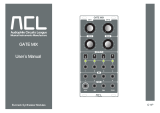
Getting to Know modDemix:
Standard AM, Balanced Modulation, Signal Multiplication, Frequency Mixing, Single Sideband, Double
Side-band and even XOR (as in Boolean logic) have all been used to implement “Ring Modulators” for
musical purposes in the last 50 years. In a way, Ring Modulation has become a catch-all term for music
technology that results in a complex, clangorous, modulated sound.
The modDemix consist of 2 identical direct coupled circuits that may be used together or independently to
process audio or control signals by means of amplitude modulation and the many derivatives of AM such as
double/ single-sideband, voltage controlled amplification/ attenuation, voltage controlled polarization or
multiplication and of course, ring modulation. The modDemix is a specialized amplitude modulation circuit
that could be thought of as a “Thru-Zero VCA,” meaning that in addition to the AM, when the Carrier signal
(called Carrier/ CV) changes phase, the resulting signal’s phase will flip as well. What makes the modDemix
unique when compared to other Balanced Modulators, is that because it is Direct Coupled, it will perform
wonderfully both as an Audio Rate modulator to implement Ring-Modulation, and as a Control Rate
modulator to implement multiplication of control voltages. Additionally, the circuit used within the modDemix
will, with ease, turn OFF around zero volts at the Carrier/ CV INput, a characteristic that makes the circuit
behave very well as a VCA. Both of the circuits feed a SUMming stage, which thus allows the module to be
used as a voltage controlled mixer. The Carrier/CV In input attenuators are “combo knobs,” acting as unipolar panel
controls. In practice, this means the SUMming stage can also be a mixer with amplitudes set by the two panel controls.
An AUXiliary IN allows for the chaining of multiple modDemix (or Optomix) units to create larger mixes. An
attenuator at the Carrier/ Control INput allows for setting the Strength or level of the incoming signal. When
performing ring modulation, adjusting the strength of the Carrier will alter the integrity of the resulting
modulated and/ or demodulated signal, thus affecting the timbre as well as the amplitude. When using the
modDemix in most other ways, the Strength control will be directly related to the amplitude of the resulting
signal.
To better understand the concepts of AM and it’s derivatives, patch a DC offset from CH. 2 of Make Noise
MATHS (using associated panel control to set the level) to Signal IN of modDemix. Patch a DC offset from
CH. 3 of MATHS to Carrier/ CV IN of the modDemix. Set modDemix Strength to full CW. Take output from
Signal OUT on modDemix, patch to an Oscilloscope, DVM for visual feedback, or patch to the 1V/ Octave
input on a VCO and listen to the results. Setting a +3V offset at the Signal in, and +5V offset at Carrier/ CV
IN would result in a +3V Signal OUT. A +3V Signal IN and a -5V signal OUT would result in a -3V Signal
OUT. Please note that because it is designed for musical purposes, the modDemix Carrier/ CV IN is scaled
so as to operate with voltages typical of the euro format modular synthesizer, which is why it takes +5V at
Carrier to generate the +3V Program Signal at the OUT.
Now replace the DC Offset signal patched to the Signal IN on modDemix, with that of a VCO, preferably a
SINE waveform, at audio rate. Leave MATHS CH. 3 patched to Carrier/ CV IN. Patch modDemix Signal
OUT to your monitoring system. Adjust MATHS CH. 3 from full CCW to full CW and observe the change in
amplitude and phase. Listen for the point at which the sound goes “Thru-Zero.”
Now remove the DC Offset signal patched to the Carrier/ CV IN, and replace with the MATHS SUM OUT. Be
sure to set MATHS CH. 2 and 3 to 50% (NULL). Leave the VCO patched to modDemix Signal IN. Initiate the
CYCLE behavior on CH. 1 MATHS. Adjust the MATHS CH. 1 attenuvertor to around 3 o’ Clock. Observe
standard Amplitude Modulation. Listen for the presence of Sidebands, and “Carrier Feed-Through.”
Experi-ment with the rate of MATHS cycling, and the Strength control.

















